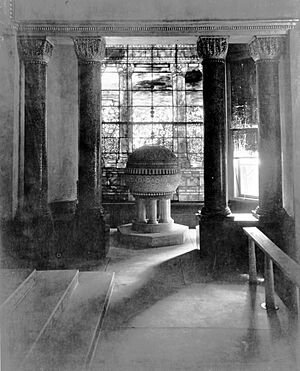Tiffany Chapel facts for kids
The Tiffany Chapel is a special room designed by Louis Comfort Tiffany and built by his company, the Tiffany Glass and Decorating Company. It's like a beautiful, artistic church room. It was first shown at a big event called the 1893 World's Columbian Exposition in Chicago.
Later, the chapel moved to the Cathedral of St. John the Divine in New York City. Tiffany bought it back in 1916 and displayed it in his own home. After 1949, the chapel was taken apart. Some pieces were sold, but many parts are now on display at the Charles Hosmer Morse Museum of American Art in Winter Park, Florida. You can visit it there since April 1999.
Contents
What the Tiffany Chapel Looks Like
The Tiffany Chapel is designed in a style that mixes Byzantine and Romanesque art. It has many beautiful parts that fit together.
- Altar Area: There's a marble and white glass altar (a table used in religious services). It stands in front of six carved arches, each held up by two double columns. This whole area is on a raised platform made of mosaic tiles. A cross sits on the altar between two pairs of candles.
- Reredos: Behind the altar is a screen called a reredos. It shows two peacocks, which are symbols of eternal life, under a crown. This part is made from a special type of glass mosaic called Favrile glass.
- Ambo and Baptistry: On the left side, you'll see the ambo, which is like a stand for reading. It has two candlesticks next to it. On the right is the baptistry, a place for baptisms. Its front has four columns, and its back features a large, colorful stained-glass window called "Field of Lilies." This window also has a column pattern. In the middle of the baptistry is a round baptismal font, sitting on a hexagonal base with columns.
- Chandelier and Windows: A large, emerald-green glass chandelier hangs from the ceiling. It's shaped like a cross and lights up. The chapel's windows are made of Tiffany glass, using a mosaic style. They show Christian stories, like Christ Blessing the Evangelists and The Story of the Cross.
- Furnishings: Inside, there are also wooden benches for people to sit on. At the museum, the chapel covers an area of about 100 square meters (1082 square feet).
The Chapel's Journey Through Time
Being a Showpiece at the World's Fair
In 1893, the chapel was smaller, about 74 square meters (800 square feet). It was set up as a special showpiece in the Manufacturers and Liberal Arts Building at the 1893 World's Columbian Exposition. Tiffany reportedly said it was "a chapel in which to worship art." About 1.4 million people visited it, and it was greatly admired. The chapel brought Tiffany international fame and won 54 awards.
Moving to a Cathedral
After the fair, the chapel was taken apart and stored away. In 1898, a woman named Celia Whipple Wallace bought the chapel for $50,000. She wanted it to be installed in the Cathedral of St. John the Divine, which was being built in Manhattan. It was placed in the basement crypt, with plans to move it into the main church later.
However, when a new architect, Ralph Adams Cram, took over, the cathedral's style was changed to "Gothic." The Tiffany Chapel, with its different style, stayed in the basement. It was used as a chapel for about twelve years (from 1899 to 1911). This was the only time it truly served as a chapel. After the main choir area above was finished, the chapel was no longer used and started to fall apart.
Returning to Tiffany's Home
After 1916, Louis Comfort Tiffany bought the chapel back. He had it repaired and replaced any damaged parts. He then installed it in its own building on his Long Island estate, called Laurelton Hall.
After Tiffany passed away in 1933, his estate changed. The Tiffany Foundation took the chapel apart in 1949 and sold some of its pieces.
Finding a New Home at the Morse Museum
In 1957, a fire destroyed the main building at Laurelton Hall. The remaining parts of the chapel were in bad condition and were almost destroyed. But Jeannette G. and Hugh F. McKean came to Laurelton Hall to save its windows and other architectural pieces for the Morse Museum in Winter Park.
They also found and bought back other parts of the chapel that had been sold. This way, the pieces of the chapel could be brought back together. After a lot of careful work to restore it, the Tiffany Chapel opened to the public at the Morse Museum in 1999.
Most of the items you see there are original, including the windows, columns, arches, decorative moldings, and the altar floor. Many of the furnishings are also original. Some parts, like the walls, ceilings, and the floor of the main area, are new. However, they were redesigned to look like the chapel did when it was at Laurelton Hall.
Other Chapels to Explore


